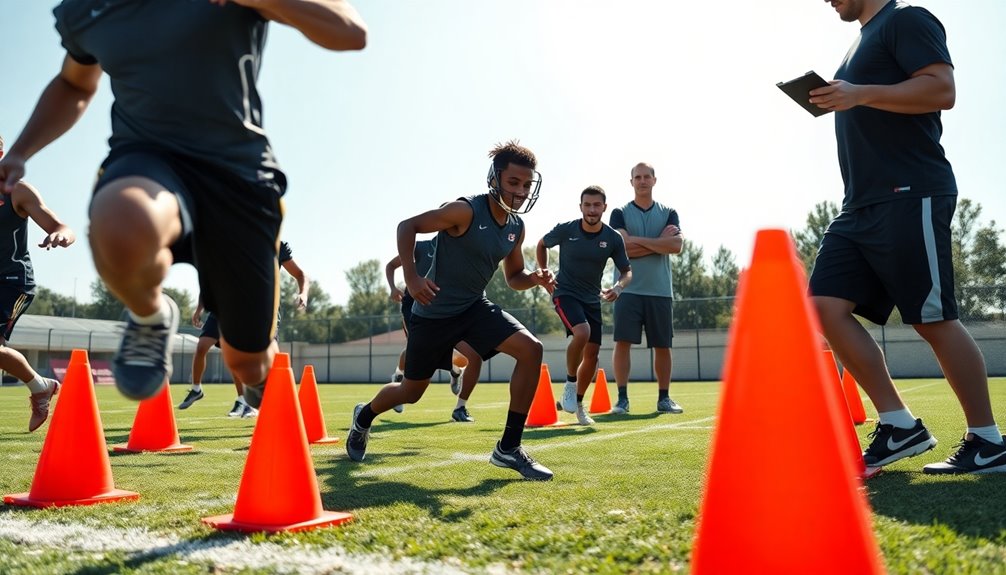
Agility Drills for Football Players to Boost Speed and Precision
January 17, 2025Agility drills are essential for football players aiming to boost speed and precision. Implementing exercises like agility ladder drills will sharpen your footwork and enhance body control. Focus on the 5-10-5 shuttle run for rapid directional changes and the T-drill to improve lateral quickness. Don't forget to warm up with dynamic stretches and plyometric exercises to prepare your muscles and reduce injury risk. Regular practice not only enhances your coordination but also builds muscle memory for quicker reactions. As you explore this topic further, you'll uncover even more techniques to elevate your performance on the field.
Importance of Agility in Football
Agility is essential for every football player, as it allows you to move swiftly and change direction on a dime. When you enhance your agility, you greatly improve your speed and coordination, fundamental for both offensive and defensive plays. By mastering agility training, you'll be able to execute sharp routes, evade defenders, and react quickly to your opponents' movements. This efficiency not only helps you improve performance but also boosts your confidence on the field. Additionally, incorporating Pain Shuttles Drill into your training can significantly enhance your overall agility.
Moreover, agility plays an important role in injury prevention. As you practice agility drills consistently, you develop better body mechanics, which can protect you from injuries that often occur due to poor movement patterns. Improved agility also enhances your reaction time and stamina, ensuring that you maintain high performance levels throughout extended gameplay. Regular incorporation of speed and agility drills boosts player performance and reduces injury risk, allowing you to excel on the field. Additionally, effective endurance training methods can further enhance your overall agility by improving your stamina during high-intensity activities.
In essence, prioritizing agility in your training regimen allows you to become a more effective football player. You'll notice the benefits in ball control and reception skills, enabling you to make critical plays when it matters most.
Benefits of Agility Drills
When you incorporate agility drills into your training routine, you'll experience a range of benefits that directly impact your performance on the field. These agility training drills can greatly improve coordination, allowing you to maintain balance under pressure. This stability is essential during contact situations, helping you stay on your feet when it counts. Additionally, engaging in agility drills enhances dynamic stretching to prepare your muscles for the demands of soccer. Incorporating speed training techniques can further amplify the benefits of agility drills, as they complement each other for enhanced performance.
Agility drills also facilitate rapid directional changes, enabling you to execute plays more effectively and evade defenders. As you practice these movements, you'll increase foot speed and enhance your overall speed, making you a more formidable opponent. Additionally, consistent training builds muscle memory, so quick reactions become second nature during gameplay.
Another key benefit is injury prevention. By promoting better movement patterns and enhancing body mechanics, agility drills reduce the risk of strains and sprains, keeping you healthier throughout the season. Furthermore, incorporating specific drills like agility ladder drills can significantly enhance your maneuverability in fast-paced game situations.
Finally, as you witness your progress and improved skills, you'll boost confidence in your abilities, allowing you to perform at your best when it matters most. Embracing agility drills not only sharpens your physical skills but also elevates your mental game, making you an all-around better football player.
Key Components of Agility Training
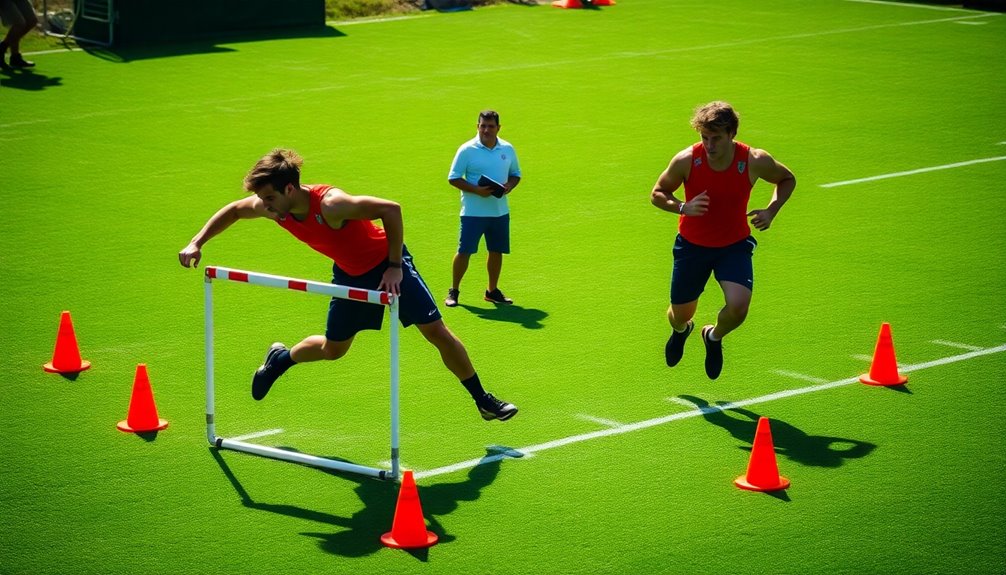
Improving your agility involves understanding its key components, which are essential for enhancing your performance on the field. Speed is a fundamental aspect, allowing you to outrun opponents and execute fast plays effectively. Regular sprinting drills can significantly improve your sprinting and quickness on the field. Additionally, incorporating interval training into your regimen can further enhance your speed and endurance for sustained performance.
To complement speed, balance plays an important role, providing stability during rapid directional changes and preventing falls that can disrupt your game.
Coordination is developed through agility training drills, improving your footwork and enabling smoother shifts between movements. This guarantees you can react quickly and efficiently, which leads us to reaction time. It's critical for making split-second decisions in the dynamic environment of football, allowing you to maneuver effectively around opponents.
Lastly, strength supports agility by facilitating explosive movements, helping you maintain high performance throughout intense gameplay. Incorporating cardio training methods into your routine can further enhance your agility by improving overall endurance and speed.
Engaging in exercises that enhance these components won't only boost your agility but also improve your overall athleticism. Consistent training focusing on speed, balance, coordination, reaction time, and strength is essential for becoming a more agile and effective football player.
Warm-Up Exercises for Athletes
Warm-up exercises are essential for preparing your body for intense training and minimizing injury risk. By incorporating dynamic stretches and plyometric drills, you'll enhance your muscle readiness and boost your performance on the field. A solid warm-up routine lasting 10-15 minutes can make all the difference in your agility and speed during practice. Additionally, incorporating dynamic exercises elevates your heart rate and prepares muscles for action, ensuring you're ready to perform at your best. This preparation also improves your passing accuracy, which is crucial for effective gameplay. Implementing team coordination during warm-ups can further enhance communication and synchronization among players, leading to better overall performance on the field.
Importance of Warm-Up
Starting your training session with effective warm-up exercises is essential for football players looking to enhance performance and minimize injury risks. These warm-up exercises increase blood flow to your muscles, enhancing flexibility and reducing the risk of injuries during high-intensity activities like football.
Incorporating dynamic stretches and sport-specific movements prepares the body for the explosive movements required in agility drills and gameplay. This thorough warm-up not only gets you physically ready but also mentally focused, setting a productive tone for practice sessions.
Studies show that proper warm-up routines can lead to a 20-30% reduction in the risk of acute injuries in athletes, underscoring their significance in your training regimen.
Additionally, enhancing muscle activation is essential for maintaining speed and precision throughout practice and games. By including plyometric exercises and mobility drills in your warm-up, you can effectively prepare the body for the demands of football.
Effective Warm-Up Techniques
A well-executed warm-up sets the stage for peak performance, making effective warm-up techniques vital for athletes. Start your routine with dynamic stretches like leg swings and arm circles. These movements not only enhance flexibility but also prepare your body for the explosive actions typical in football.
Next, incorporate plyometric exercises such as bounding and high-knees. These exercises activate your fast-twitch muscle fibers, essential for improved speed and power during gameplay. Aim for a warm-up duration of 10-15 minutes, gradually increasing intensity to guarantee you're physically and mentally ready for training or competition.
Don't forget to include sport-specific drills, like agility ladder movements, in your warm-up phase. These drills will enhance your coordination and overall agility, making you more effective on the field.
Top Football Agility Drills
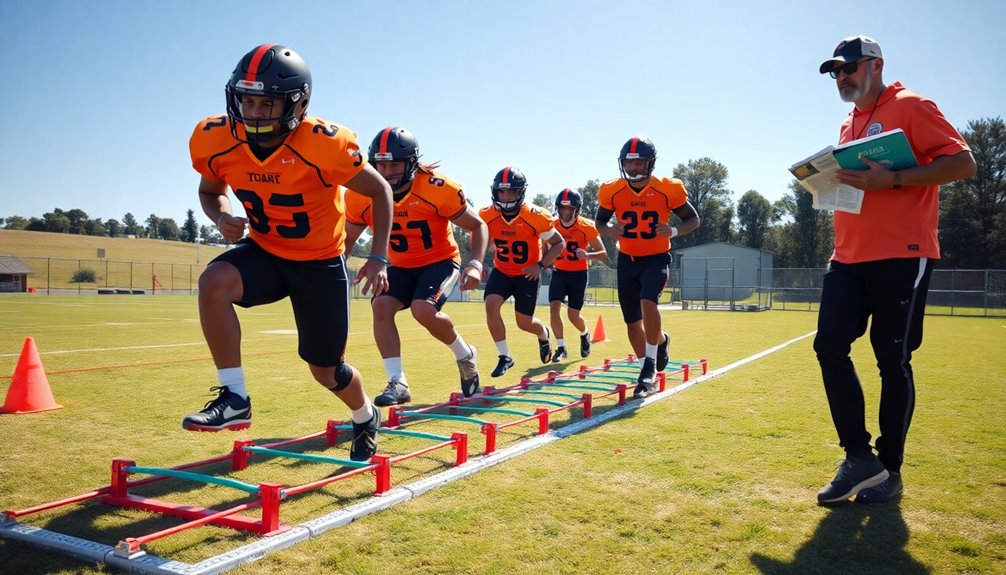
Improving your agility on the football field requires dedication to specific drills that enhance your quickness and coordination. One of the best ways to start is with Agility Ladder Drills, which sharpen your quick footwork and improve body control. These drills can significantly enhance your overall performance by developing essential skills for effective gameplay.
Follow that up with the 5-10-5 Shuttle Run, focusing on rapid directional changes that boost your lateral coordination and acceleration, essential for both offensive and defensive plays.
Next, incorporate the T-Drill into your routine. This drill combines sprinting, shuffling, and backpedaling, effectively developing your lateral quickness and overall agility performance.
Box Drills are another fantastic option; they target explosive speed and balance, requiring you to maneuver in tight spaces, which solidifies your skills for actual gameplay.
Finally, don't forget about Single Leg Hops. These enhance leg strength and explosiveness, allowing you to make quicker, more powerful movements during games. Additionally, enhancing your agility through these drills can improve your defensive positioning, helping you stay one step ahead of opponents.
Measuring Improvement in Agility
As you work on your agility, measuring your progress becomes essential for understanding your development. Timed drills like the T-drill and 5-10-5 shuttle run are effective ways to measure agility improvements. By comparing your completion times over multiple sessions, you'll see how your speed and agility enhance.
Incorporating Functional Movement Screens (FMS) can help identify movement imbalances, directing your agility training efforts to areas that need focus.
Additionally, video analysis allows you to capture and compare your techniques over time, providing a visual assessment of your progress.
Wearable technology can also be a game-changer in tracking your metrics. Devices that monitor speed, distance, and movement patterns offer real-time data to evaluate the effectiveness of your agility training.
You can even use football wristbands equipped with agility metrics to get immediate performance feedback during drills. Moreover, consistent practice is crucial for skill development and growth, ensuring that your agility training yields the best results.
Common Mistakes to Avoid
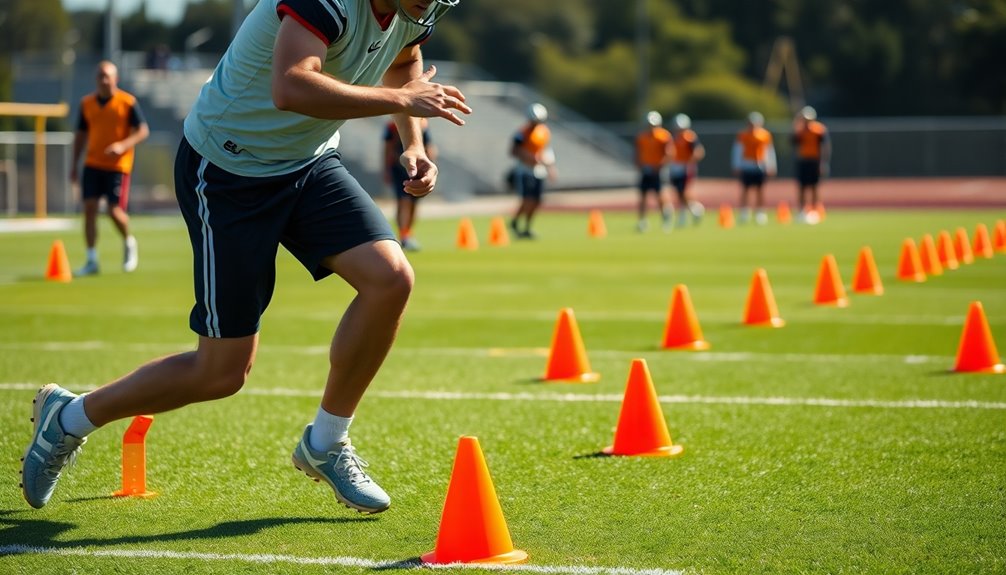
Agility training can be highly effective, but common mistakes can derail your progress. One major pitfall is failing to customize agility drills to fit your specific player needs. If you don't tailor your workouts, you risk ineffective training that doesn't foster improvement.
Another mistake is overemphasizing speed during drills at the expense of proper technique. This can lead to poor form, increasing your injury risk and undermining your agility development.
Neglecting warm-up routines before starting agility training is another critical error. A proper warm-up helps prevent injuries and enhances your overall performance during drills.
Additionally, lacking a variety of drills can limit your long-term growth. Players need diverse training to effectively improve agility and responsiveness on the field.
Lastly, inadequate planning and progression in your training can lead to stagnation. Without regularly evaluating and adjusting your methods, motivation may dwindle, and performance can plateau.
Tips for Effective Drills
When it comes to agility drills, focusing on technique is vital for maximizing your effectiveness. By honing your skills, you can improve speed and execute quicker changes of direction.
Here are some tips to help you perform your agility training exercises more effectively:
- Maintain a low center of gravity: This helps facilitate smoother shifts and enhances stability during quick direction changes.
- Avoid crossing your feet: During shuffles, keep your feet apart to minimize the risk of tripping and guarantee efficient movement patterns.
- Pump your arms vigorously: Proper arm movement boosts your speed and overall coordination, which is significant for agility.
- Gradually increase intensity: Start slow and build up the speed of your drills to gain confidence and control over time.
- Practice consistently: Regularly assess your progress to identify strengths and weaknesses, allowing for tailored adjustments to your training methods.
Equipment Needed for Drills
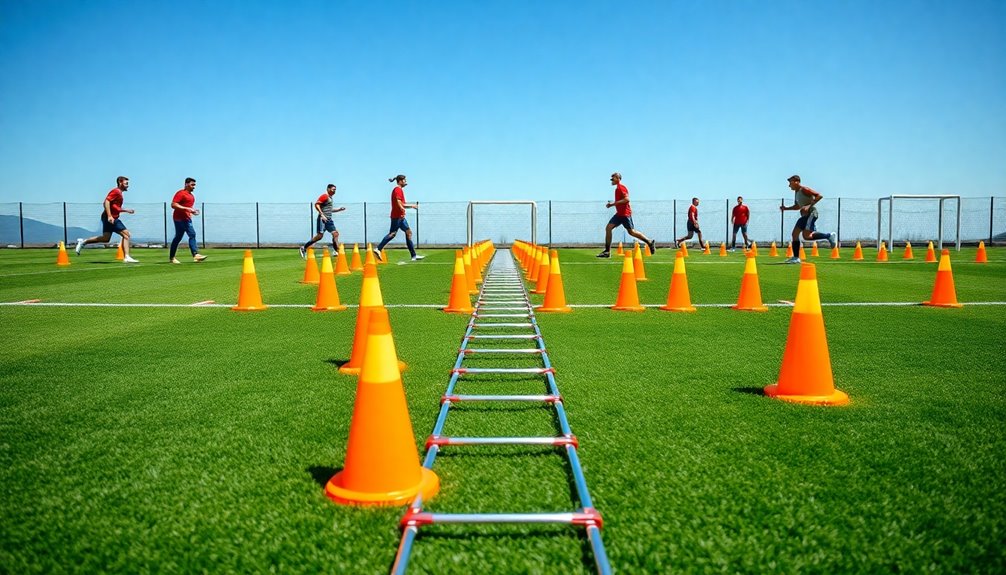
To get the most out of your agility drills, having the right equipment on hand can make a significant difference. Start with bright cones, which are vital for visibility during your workouts. They help you focus on your movements and techniques, guaranteeing you stay on track.
Durable equipment like speed ladders and agility hurdles is also key; they facilitate various drills and withstand the wear and tear of regular training sessions.
For a proper setup, position your markers thoughtfully to enhance your spatial awareness. This understanding is essential for developing agility and executing drills effectively. You can also get creative with alternative markers—tennis balls, flags, or even shoes can serve well in setting up drill patterns.
Don't forget about portable equipment; it's perfect for easy transport to different training locations. This flexibility guarantees you practice consistently, no matter where you are.
Youth Football Agility Drills
Elevating your game starts with honing your agility through targeted drills designed for youth football players. These youth football agility drills are important for developing the skills needed to quickly change direction, improve foot speed, and boost players' overall performance on the field.
Incorporating a variety of drills into your training routine can help you gain explosive power and speed.
Here are five effective drills to take into account:
- 4-Corner Drill: Enhances backpedaling and shuffling, essential for direction changes.
- Zig Zag Drill: Improves quick direction changes, especially beneficial for wide receivers.
- Foot Fire Drill: Focuses on rapid leg movement to improve footwork and increase quickness.
- Lateral Box Drill: Boosts sideways shuffling, critical for defensive positioning against opponents.
- T Drill: Centers on acceleration and quick pivots, reinforcing agility for all players.
Incorporating these football agility drills into your practice won't only refine your coordination but also prepare you for significant moments during games.
The consistent practice of these training drills will guarantee you stand out on the field, equipped to navigate any play effectively.
Advanced Agility Training Techniques
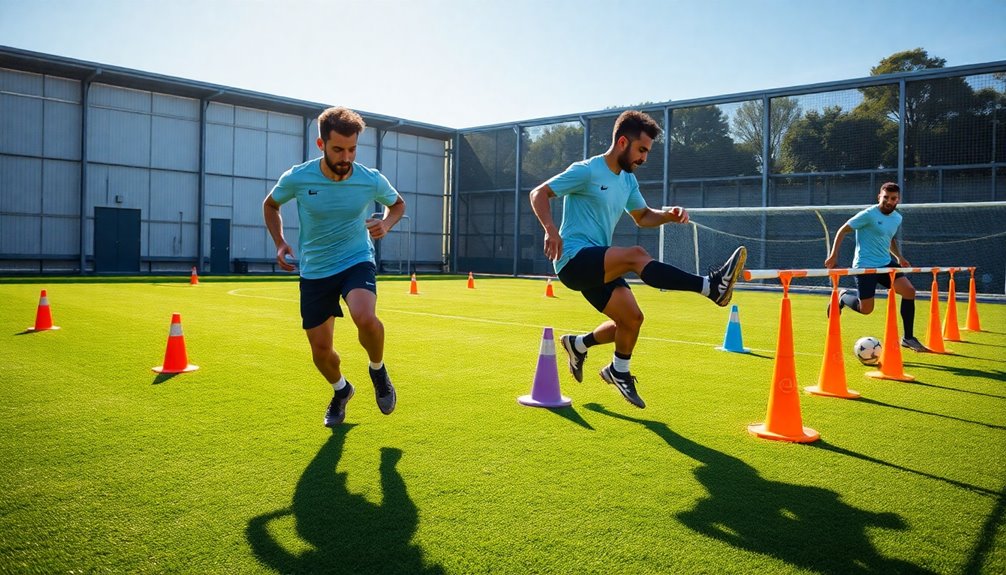
To take your agility to the next level, focus on plyometric exercises that build explosive power, like lateral jumps and shuttle runs.
Incorporating advanced footwork patterns into your drills will sharpen your ability to change direction quickly on the field.
With consistent practice, these techniques can greatly enhance your overall performance in football.
Plyometric Power Development
Plyometric power development is a crucial component of advanced agility training for football players. By incorporating plyometric exercises into your training routines, you can greatly boost your explosive power, which is essential for quick acceleration and sharp directional changes. This power translates directly into improved speed and agility on the field.
Consider these benefits of plyometric training:
- Enhanced explosive power for faster starts and better sprints.
- Improved muscle elasticity, allowing for more efficient movements.
- Performance improvement in both vertical leap and sprinting capabilities.
- Reduced risk of injuries through strengthened muscle ligaments and better body mechanics.
- Incorporation of football drills that mimic game scenarios, increasing on-field effectiveness.
Engaging in plyometric drills, like lateral jumps and box jumps, at least 2-3 times a week can lead to impressive gains.
Studies show that athletes can experience a 10-20% improvement in performance through consistent training.
To maximize your results, consider using equipment like the VertiMax for added resistance, further intensifying your plyometric exercises.
This approach not only hones your agility but also guarantees you stay competitive and injury-free.
Advanced Footwork Patterns
Building on the explosive power gained from plyometric training, mastering advanced footwork patterns can remarkably elevate your agility on the field. Incorporating advanced agility training exercises like the L Drill and 5-10-5 Shuttle Run enhances your ability to change direction quickly, which is essential for effective route running and defensive maneuvers.
Agility ladder drills are important for improving foot coordination and speed, allowing you to execute complex footwork with precision during gameplay. Single leg hops not only build explosiveness but also enhance balance and stability, significant for maintaining control during those rapid directional changes.
To further develop quick bursts of acceleration, practice forward running high-knee drills with a speed ladder. This targets both foot coordination and speed, making you a more agile player.
Additionally, utilizing plyometric agility hurdles in various patterns will increase your explosive power and overall agility, giving you an edge in tight situations against defenders.
Technological Innovations in Training
In today's fast-paced world of football training, technological innovations are transforming how players enhance their agility and performance. These advancements not only improve your skills but also provide insights that were previously unattainable. By integrating technology into your training program, you can achieve significant gains in agility and explosive power.
- GoRout On-Field Practice App: Enables real-time adjustments during drills, enhancing communication between coaches and players.
- Wearable player devices: Offer discreet feedback through vibrations, helping you stay focused on executing your drills.
- Video analysis technology: Captures your techniques, allowing for detailed performance reviews and targeted improvements.
- Performance metrics platforms: Track your speed, distance, and movement patterns, helping identify areas for improvement.
- VertiMax resistance training systems: Integrate seamlessly into agility drills to build strength and enhance overall athletic performance.
Incorporating these technological innovations into your agility training will help you pinpoint weaknesses, refine your skills, and ultimately elevate your game on the field.
Embrace these tools to stay ahead of the competition and maximize your potential.
Resources for Coaches and Players
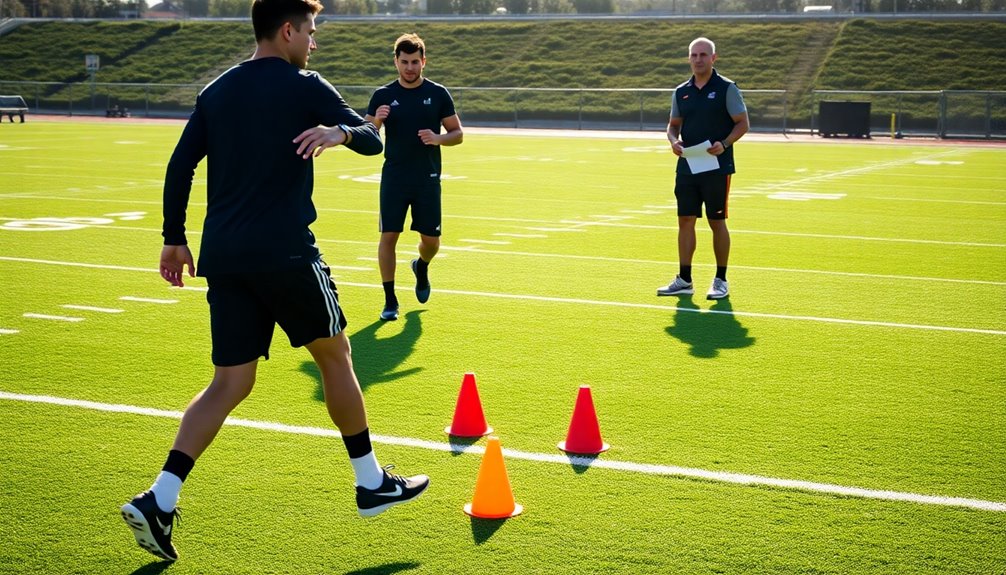
As a coach or player, you've got access to a wealth of training materials online that can enhance your agility drills.
Performance tracking tools can help you monitor progress and adjust your training effectively.
Plus, community coaching resources offer a great way to share tips and learn from others in the field.
Training Materials Availability
Finding the right training materials can make a significant difference in your development as a football player or coach. These resources help you implement effective agility drills and refine your football practice plan. Here are some valuable options to take into account:
- Technique Improvement Videos: Visual aids can enhance your understanding of drills.
- Local Clinics: Hands-on training sessions provide expert guidance to elevate your skills.
- Community Forums: Join discussions to share tips and experiences with fellow coaches and players.
- Performance Tracking Tools: Monitor your progress over time to see improvements in agility.
- Contact Resources: For additional support, reach out to [email protected] or call 1-844-940-1005.
Utilizing these training materials allows coaches to create more efficient practices and improve player-coach interactions during agility drills.
By engaging with these resources, you can guarantee that you're not only enhancing your skills but also fostering a supportive environment for your team.
Online Performance Tracking
Tracking your performance online can revolutionize how you approach agility training in football. With the right tools, you can monitor key metrics like speed, distance, and movement patterns in real time. This data-driven approach enables you to make informed coaching decisions, enhancing your training effectiveness.
Wearable technology plays an essential role in capturing your agility performance during drills. These devices provide valuable insights into your strengths and pinpoint areas for improvement. By regularly evaluating your metrics, you can identify trends and adjust your training plans to meet specific agility goals.
Additionally, platforms offering video analysis allow you to assess your technique critically. You can compare your performance against set benchmarks, ensuring you're on track to improve speed and overall agility. This visual feedback is fundamental for refining your skills.
Online performance tracking not only helps you monitor progress but also fosters a deeper understanding of your training journey. By leveraging these resources, you can maximize your agility training drills and achieve significant performance improvements.
Embrace the power of technology and watch your game elevate to new heights!
Community Coaching Resources
Community coaching resources are invaluable for both coaches and players looking to enhance agility training in football. By tapping into these resources, you can greatly improve your skills and knowledge.
Here are some essential tools to take into account:
- Community forums: Share tips, experiences, and best practices with fellow coaches and players.
- Local clinics: Participate in hands-on training sessions where you can learn agility training drills from experienced coaches.
- Online coaching materials: Access videos and articles to refine your training techniques and improve your methods.
- Performance tracking platforms: Monitor your progress in agility drills and adapt your training routines based on real-time data.
- Networking opportunities: Attend workshops to gain valuable insights and innovative strategies for agility development in football.
Utilizing these coaching resources can help you stay current with the latest training techniques and enhance your performance.
Whether you're a player seeking to boost your agility or a coach looking to elevate your team's skills, these resources are vital for achieving your goals.
Embrace the community and watch your agility soar!
Game Strategies and Agility
Agility plays an essential role in successful football game strategies, allowing players to execute rapid movements and adapt to the dynamic nature of the field. When you incorporate agility drills into your training, you enhance your ability to change direction quickly, which is crucial for evading defenders or making sharp cuts during plays. Drills like the 5-10-5 shuttle run specifically target these skills, improving your speed and overall performance.
As a football player, enhanced agility translates to quicker decision-making on the field. You'll find that you can better read the game and react faster, leading to higher reception rates and successful evasion techniques.
Consistent agility training not only sharpens your individual skills but also promotes better team cohesion. When everyone on the team can move fluidly and synchronize their movements, the overall effectiveness of game strategies increases.
Moreover, focusing on agility helps improve body mechanics, reducing injury risks during high-intensity situations. By prioritizing agility in your training regimen, you set yourself up for success in both individual performance and teamwork on the field.
Conclusion
Incorporating agility drills into your training can make a significant difference in your performance on the field. Did you know that athletes who regularly practice agility drills can improve their speed by up to 10%? By honing your agility, you're not just boosting your speed; you're also enhancing your precision and overall game strategy. So, make agility training a priority, and watch how it transforms your skills and gives you the edge over your competition.


